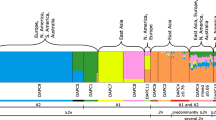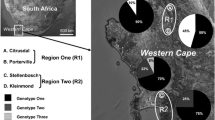Abstract
Populations of Melampsora larici-populina, causal agent of poplar leaf rust, have been collected during 1992–1994 in three types of sites: natural stands of Populus nigra in the south-east of France; cultivated poplar stands in the northern half of France, including mainly interspecific and exotic hybrids of poplar; and two overseas populations collected from Northern Ireland and Western USA. The pathotype of each rust isolate was determined by inoculating a differential set of poplar clones. The number of virulences per isolate and the frequency of each virulence in each population were compared, according to the sites and to the clones from which the isolates were collected.
Several diversity indices were applied to the populations. The α and Simpson indices were retained since they described best the richness and the evenness, respectively, of the populations, and they were the least sensitive to sample size. The complexity of races was lower in the natural stands of P. nigra than in the cultivated poplar stands. Populations of M. larici-populina collected on Populus × euramericana ‘Robusta’ and P. nigra ‘italica’ (Lombardy poplar) presented a high richness and evenness, confirming the value of these clones for describing race populations. Populations from Western USA presented a very low diversity, which is in accordance with the recent introduction of the pathogen in North America. These results suggest that the race populations of M. larici-populina are mainly influenced by the structure of the host populations.
Similar content being viewed by others
References
Andrivon D and de Vallavieille-Pope C (1995) Race diversity and complexity in selected populations of fungal biotrophic pathogens of cereals. Phytopathology 85: 897-905
Arbonnier P (1966). L'analyse de l'information. Aperçu théorique et application à la loi multinomiale. Ann. Sci. For. 23: 949-1017
Groth JV and Roelfs AP (1987) The concept and measurement of phenotypic diversity in Puccinia graminis on wheat. Phytopathology 77: 1395-1399
Kolmer JA (1991) Phenotypic diversity in two populations of Puccinia recondita f. sp. tritici in Canada during 1931-1987. Phytopathology 81: 311-315
Lefèvre F, Pichot C and Pinon J (1994) Intra-and interspecific inheritance of some components of the resistance to leaf rust (Melampsora larici-populina Kleb.) in poplars. Theor. Appl. Genet. 88: 501-507
Magurran AE (1983). Ecological Diversity and Its Measurement. University Press Cambridge, 179 pp
Newcombe G and Chastagner GA(1993) First report of the Eurasian poplar leaf rust fungus, Melampsora larici-populina, in North America. Plant Dis. 77: 532-535
Pinon J (1984). Management of poplar diseases. Eur. J. For. Path. 14: 415-425
Pinon J (1992) Frequency and evolution of Melampsora laricipopulina Klebahn races in north-western France. Ann. Sci. For. 49: 1-15
Pinon J (1995) Variabilité des rouilles du Peuplier et évolution de leurs populations. Conséquences sur les stratégies de lutte. CR Acad. Agric. Fr. 81: 99-109
Pinon J and Bachacou J (1984) Fr Existence de deux groupes d'isolats différant par leur pouvoir pathogène chez Melampsora laricipopulina Kleb. C. R. Acad. Agric. Fr. 70: 114-122
Pinon J and Lefèvre F (1994)A new virulence found among isolates of M. larici-populina. International Poplar Commission, Izmit (Turkey), 3-7 October, 8 pp
Pinon J and Peulon V (1989) Mise en évidence d'une troisième race physiologique de Melampsora larici-populina Kleb. en Europe. Cryptogam. Mycol. 10: 95-106
Pinon J and Schvester D (1985) Problèmes sanitaires dans les taillis àcourte rotation. Rev. For. Fr. 37: 17-25
Pinon J, Newcombe G and Chastagner GA (1994) Identification of races of Melampsora larici-populina, the Eurasian rust fungus, on Populus species in California and Washington. Plant Disease 78: 101
Pinon J, van Dam BC, Genetet I and De Kam M (1987) Two pathogenic races of Melampsora larici-populina in north-western Europe. Eur. J. For. Path. 17: 47-53
Steenackers M, Steenackers V and Delporte T (1994) A new race of M. larici-populina in Belgium. International Poplar Commission, Izmit (Turkey), 3-7 October, 8 pp
Steenackers V (1982) Fr Nouvelle race physiologique de M. laricipopulina en Belgique. FAO/CIP, 22e réunion du Groupe de Travail desmaladies, Casale Monferrato, 6-10 September 1982, 6 pp
Van Vloten H (1949) Kruisingsproeven met rassen van Melampsora larici-populina Klebahn. Tijdschr. Pl. Ziekt. 55: 196-209
Villar M, Lefèvre F, Augustin S, Bonduelle P, Delplanque A, Duval H, Faivre-Rampant P, Goué M-C, Legionnet A, Ménard N, Nesme X, Pilate G, Pinon J, Valadon A and Teissier du Cros E (1995) Perspectives d'amélioration génétique des peupliers en France. C.R. Acad. Agric. Fr. 81: 137-152
Author information
Authors and Affiliations
Rights and permissions
About this article
Cite this article
Pinon, J., Frey, P. Structure of Melampsora larici-populina populations on wild and cultivated poplar. European Journal of Plant Pathology 103, 159–173 (1997). https://doi.org/10.1023/A:1008650128568
Issue Date:
DOI: https://doi.org/10.1023/A:1008650128568




